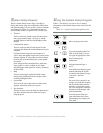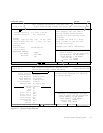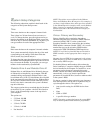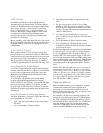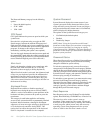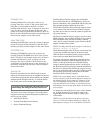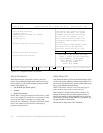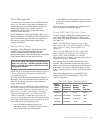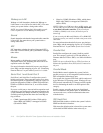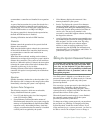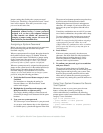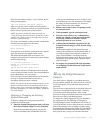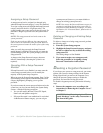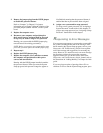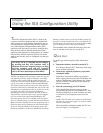
2-10 Dell OptiPlex GXa Mini Tower Systems Reference and Installation Guide
Wakeup on LAN
Wakeup on LAN determines whether the Wakeup on
LAN feature is set to Off or On (Add-in NIC). You must
reboot your system before a change takes effect.
NOTE: An optional Wakeup On LAN-capable network
card is required to use the Wakeup On LAN feature.
Sound
Sound determines whether the integrated audio controller
is On or Off. You must reboot your system before a
change takes effect.
NIC
NIC determines whether the optional integrated NIC is
On or Off. You must reboot your system before a change
takes effect.
Mouse
Mouse enables or disables the system’s built-in PS/2-
compatible mouse port. Disabling the mouse allows an
expansion card to use IRQ12.
For more information about built-in ports, port designa-
tions, IRQs, and the remapping of ports, see “Connecting
External Devices” in your online
System User’s Guide
.
Serial Port 1 and Serial Port 2
Serial Port 1 and Serial Port 2 configure the system’s
built-in serial ports. These categories can be set to Auto
(the default option) to automatically configure a port, to a
particular designation (COM1 or COM3 for Serial
Port
1;
COM2 or COM4 for Serial Port 2), or to Off
to disable
the port.
If you set a serial port to Auto and add an expansion card
containing a port configured to the same designation, the
system automatically remaps the built-in port to the next
available port designation that shares the same IRQ set-
ting as follows:
•
COM1 (input/output [I/O] address 3F8h), which
shares IRQ4 with COM3, is remapped to COM3
(I/O address 3E8h).
•
Likewise, COM2 (I/O address 2F8h), which shares
IRQ3 with COM4, is remapped to COM4 (I/O
address 2E8h).
NOTES: When two COM ports share an IRQ setting, you
can use either port as necessary, but
you may not be able
to use them both at the same time
. If the second port
(COM3 or COM4) is also in use, the built-in port is
turned off.
If you are using the Microsoft Windows 95 or IBM OS/2
operating system, you cannot use both serial ports at the
same time.
For more information about built-in ports, port designa-
tions, IRQs, and the remapping of ports, see “Connecting
External Devices” in your online System User’s Guide.
Parallel Port
Parallel Port configures the system’s built-in parallel
port. This category can be set to 378h
(the default), to
alternate addresses
278h or 3BCh, or to Off to disable the
port.
NOTE: Do not set Parallel Port to 278h if you have an
Enhanced Capabilities Port (ECP) device connected to
the port.
Parallel Mode
Parallel Mode controls whether the system’s built-in
parallel port acts as an AT-compatible (unidirectional) or
PS/2-compatible (bidirectional) port.
Your system also supports ECP mode, which can be used
by the Windows 95 operating system. Windows 95 uses
ECP protocol automatically if it detects an ECP-capable
device, eliminating the need for an ECP option in this
category.
Set this category according to the type of peripheral
device connected to the parallel port. To determine the
correct mode to use, see the documentation that came
with the device.
IDE Hard Disk
IDE Hard Disk enables or disables the system’s built-in
EIDE hard-disk drive interface.
With Auto (the default option) selected, the system turns
off the built-in EIDE interface when necessary to



